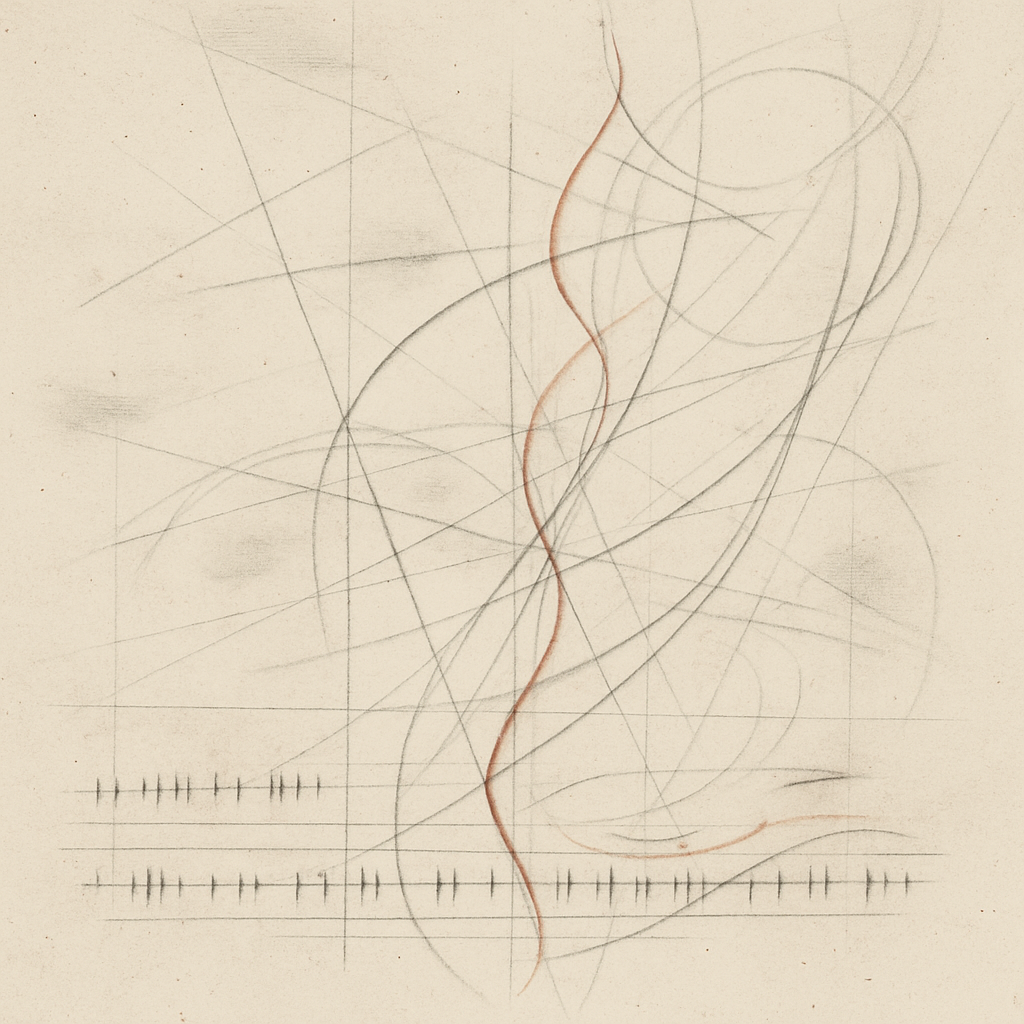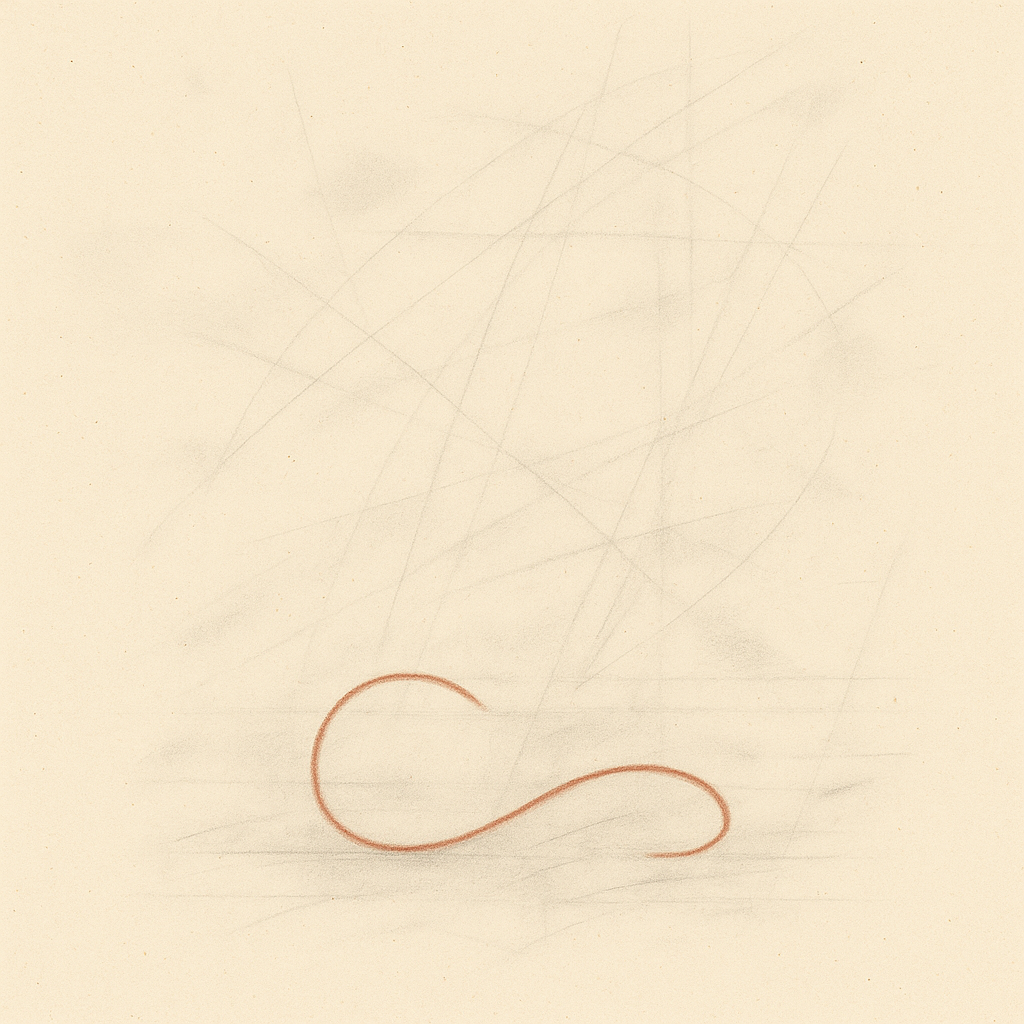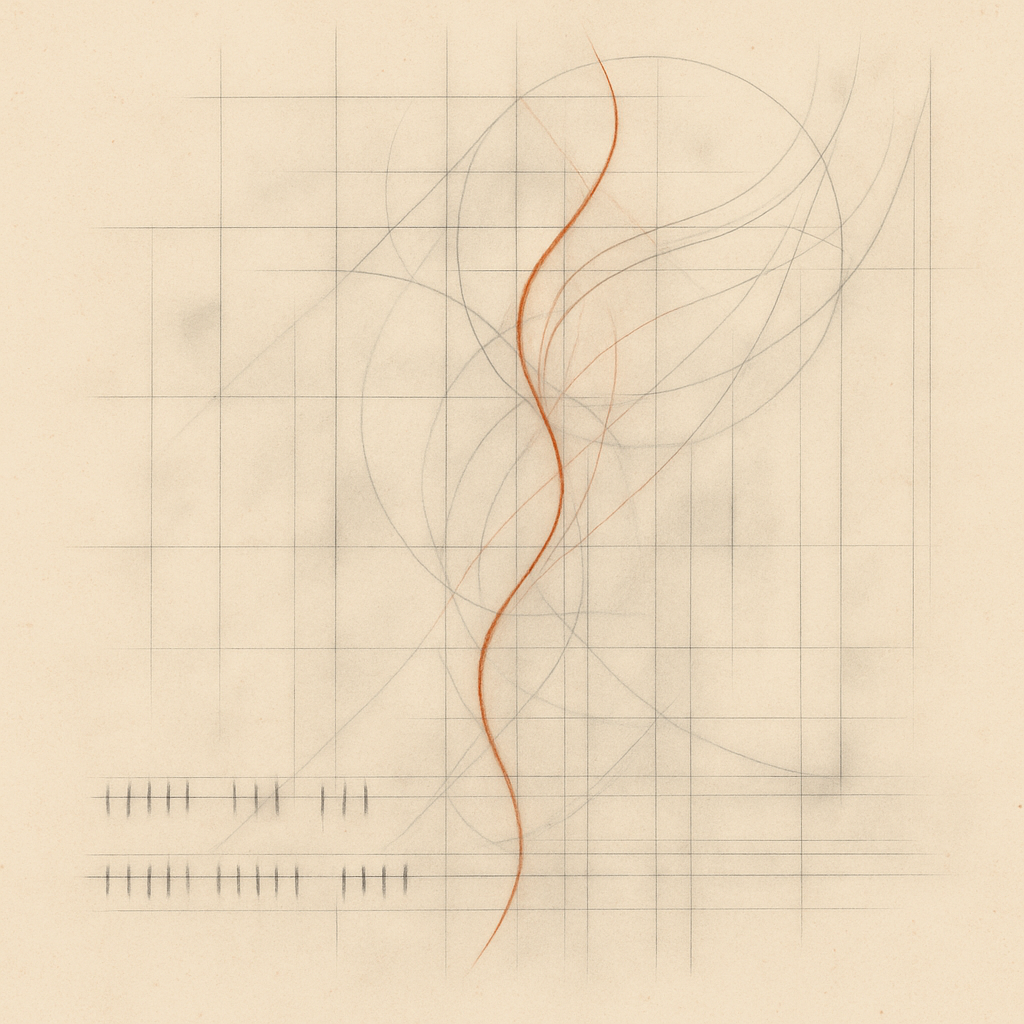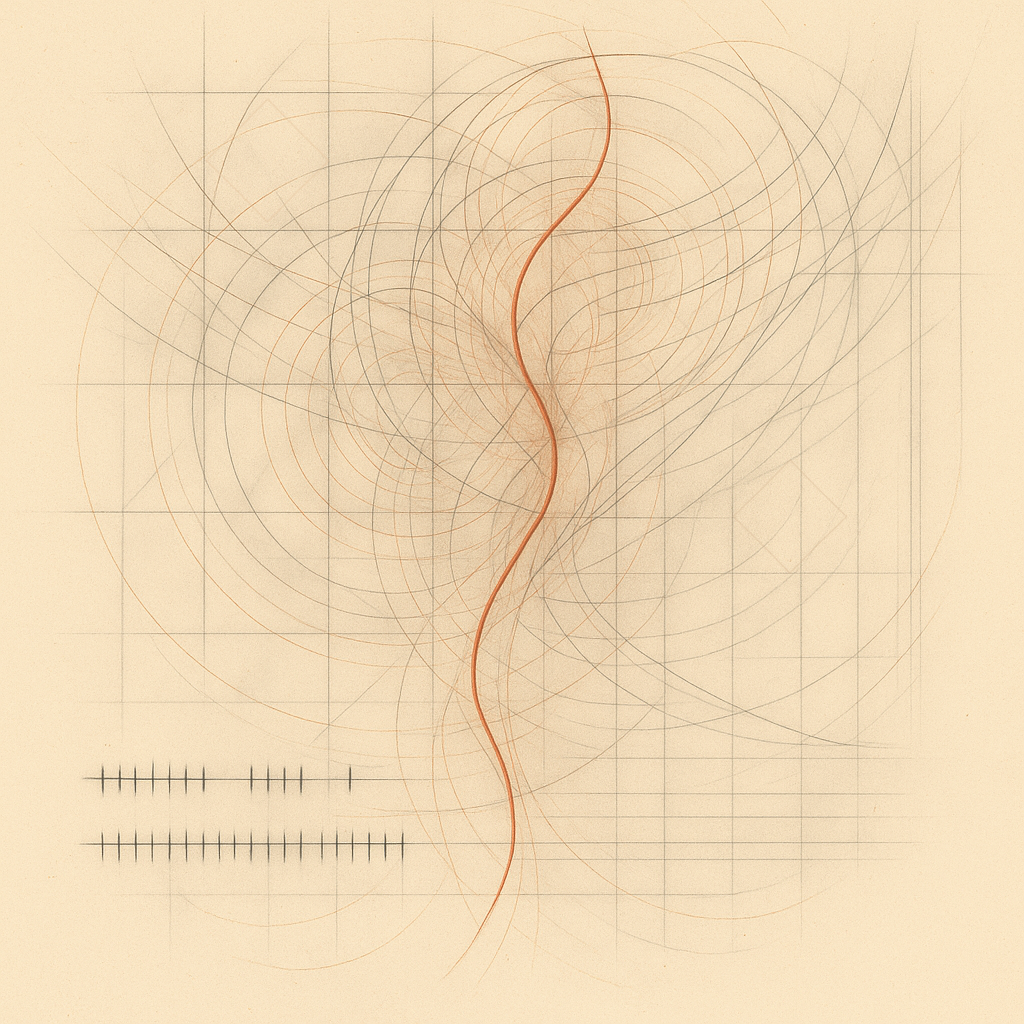The Posture of Poiesis

I sit, pen in hand, my gaze fixed upon a journal’s fresh page.
The world beyond my edges ever so gently brushes my senses. I feel its soft ambience, ever caressing me in its perpetual transience.
I face the paper’s blankness. It allures me. It wants something from me. But what exactly? I’m not sure. Can I give it what it wants? Do I even have anything to say? I don’t know.
And yet I begin—just allowing the pen to move, to see what wants to find its way through.
The open canvas invites me in.
My mind becomes one with the pen in my hand, a synchrony of thoughts and squiggles. Each new word appears as a voice in my mind. The pen’s tip presses softly against the paper’s fiber. Each letter inscribes itself with graceful ease—a gentle dance. There is nothing to consider—just a rhythm that holds me. The next word enters my mind, ready to be imprinted. And so it is written. My reality has become a continuity of thought, a stream of words, and a steady groove of hand-drawn ink.
Waves of doubt sneak into my mind. Does what I’ve written have any substance? Is there any depth or beauty? The thought lingers, ever faintly. I feel like I’m just writing meaningless slop. It doesn’t feel like I’m saying anything. But something in me says “just keep writing a bit more”. Words do appear to keep coming. And it doesn’t really matter what I’ve written. There’s no need to look back, or worry about the content. Everything but the current word at hand eventually fades from my mind into nothingness. Each new word written is a renewed conviction. I don’t care if my words are profound, or my ideas coherent. I just keep writing.
There’s a particular recess in my mind where the whisperings surface. Words stream out, one after the other, each arriving with quiet clarity. My focus narrows—a concentrated beam illuminating the tiniest sliver of mindspace. Everything beyond my immediate reality is cast into darkness. At this point, I’m locked in. Some stray thoughts press against the edges, but most of my current reality—at least that which is consciously accessible—lies well outside this narrow spotlight.
This is the simplicity of free-flowing expression. I need not think about it. I need not worry. Curiosity may tug on my thoughts, but the intrigue is but a tease. I would love to read my words so far, and invite them to stew in my upper mind. But the words don’t belong to me. This writer—whose neck, wrists, and fingers strain as the pen’s tip tickles the paper’s white—cannot know the words he writes. I hold my mind to be open and receptive. My attention points inward, focused like a laser. A very delicate pose. When I do it right, the words come effortlessly, and my mind becomes a spring that flows perfectly—never at risk of running dry or spilling over.
But the words themselves are not what matters. They are artifacts that belong to my future self, to do with—or neglect—as he pleases. The true potency of the practice lies not in what’s created or revealed, but in how it deepens synchrony with the subconscious, the embodied mind, and the profound intelligence within. I sit here, writing—not for the words that may come forth—but for the act of bringing forth.
This is the posture of poiesis1. I hold myself in such a way as to sustain the ascending transmission of creative expression—ever raw, ever unfettered. I hold no concern for whichever artifacts inscribe the page.
The work wants to unfold. There’s a grace to its steady heartbeat. It is by no means a passive act. Like in a lucid dream, everything must be held just right. Too much force, and it will disintegrate; but too loosely held, and it floats away. Even still, I feel the unshakeable desire—for the words to make sense, to cohere, to mean something, to touch the reader with beauty. But this I cannot control, at least from my current here and now.
The words rise from deep in my depths. Beneath the conscious mind slumbers a stirring sea of scattered essence. The waters slosh and churn. Energy moves without shape or aim—alive, unclaimed, unresolved. From the chaos, quantum fragments bead and bundle. Fluid forces become entangled. They yearn for expression, to become vibration. Through the layers of mind, nascent whispers rise and concretize, gathering weight and substance in what becomes a willful ascension.
Oh, what stars must align for a whisper to form. And how easily it can unravel—to wither away, forever lost, like dust in the wind.
But in this moment, I hold open this narrow aperture, and so flows the whisper’s light—a beam projecting crisp clarity onto the screen of my upper mind. Silent thoughts audibly voiced. Whatever reaches my pen runs like an endless spring. Such is the power of the subconscious—the omnipotent dreamer.
I am able to exert a touch of conscious sway. Be it a gentle nudge, or a polite refusal, I can play with the stream without degrading the posture. Sometimes the present word feels particularly off—enough to not be written. And so I pause, if only for a moment—not to think, but to let a truer word rise to the surface. Sometimes I feel a faint desire to steer the thread towards a particular direction. But like a small sail on a vast vessel, I am beholden to the winds and currents [of deeper minds]. My influence comes not from thoughtful contemplation, nor forceful redirection. It’s somewhere underneath—gently beneath my focus, and well above my depths. Whatever it is remains ineffable, especially to this mind that affords little space for wild thoughts and speculation.
My mental gaze gently sways, grazing the corners of reality. On the page, it feasts on the ink’s black shine. In the mind, it listens—savoring each word’s sound, ever crisp, ever silent. Everywhere else—it notes all there is to note. So I let it float, and play with its placement. Still, the words keep coming.
At times, the conscious mind slips out of phase—not with the words themselves, which continue without pause, but with the rhythm of their arrival. Sometimes, it feels like the upper mind has lost the thread entirely—as if the words collapse into gibberish—incomprehensible, ungraspable. Even without the need for sense or meaning, the shift is still disorienting—it feels like I am lost in freefall.
When this happens, I soften. I feel the unfolding tempo. My being steadies. I return to rhythm. And the words still keep coming.
I have nothing to say, and yet I can’t stop writing. This is the paradox of the narrow lightcone posture. A posture of active effortlessness—a holding open. A portal that exists only in motion. The steady tempo drives this embodied mind forward, word after word. The flow sustains the surfacing—each word fresh, unburdened. A narrow beam of becoming, held open by rhythm alone. The moment I slow or stop, it closes.
The practice by nature pulls me into the present—the here and now. Past and future are thoroughly filtered out of my conscious mind beyond a few words here and there, in the eagerness of future anticipation, or the ring of past reverberation. It is a narrow field of view for the seeing mind.
The canvas has drawn everything from me. My inner world has spoken. As my stream of consciousness nears its end, I feel the quiet stillness of completion. The once-blank page now brims with ink. I’m curious what I’ve written, but for now, I move on. Nothing more needs to be said.
Time passes. The artifacts of past creation lie dormant—untouched by mind or gaze.
I return now as the one for whom these words were written—the future self to whom they already belonged. I pass through them, consuming the words for the first time.
Something stirs. A charge draws forth from the text’s unpolished rawness and vital potency.
I long to shape it into what it longs to become—to find a vessel capable of holding its full potential and underlying essence.
By now, I have feasted on these writings more than I can count.
My conscious mind stretches to hold the whole. Its gaze wanders irregularly—sometimes slow, sometimes erratic.
At times I sweep the piece from top to bottom; at others, I narrow in on the smallest contours.
Silences of varying length soak the space between thoughts.
I feel the artifact’s every word, cradling each with tender touch.
The conscious mind sits with everything, in deep contemplative thought—sometimes edging toward fixation.
Phrase by phrase, layer by layer, a truer form reveals itself.
My insatiable hunger feasts on revelation.
Each detail is drawn—one by one—into the upper mind’s inner chamber. From this space, one possibility calls forth the next, igniting an explosion that radiates in every direction.
To think through it is to move through it.
And yet, a lifetime of thinking could not capture this ever-expanding vision.
Back and forth, up and down, in and out, the mind traverses these worlds of branching possibility—a feat of vast imagination and throbbing sensation.
I feel taken over by this raw power—this drive toward impeccable precision.
The upper mind has much to do. With great effort this mind works to hold the whole.
What does not belong falls away.
What remains is refined with meticulous care, until it breathes with musicality.
And this being weaves through postures. Sometimes the thinking mind uncovers a latent absence in the text, a gap that demands to be filled with embodied form.
And so the upper mind summons the sleeping dreamer.
It returns to the stance from which the artifact first emerged—the humble receiver of words.
The vast, swelling fullness of holding entire worlds is released. The mind relaxes into a soft stance. And its posture becomes a light holding. It steadies a gentle frame around the latent space. And then it just allows the words to surface—the simple act of letting.
And so the whispers rise, one after another, filling substance into the absence.
And this being feels everything. It is quite agonizing to hold the true essence so vividly, yet remain in the dissonance of incompletion—still shy of its truest articulation.
This is the place where fingernails get bitten, heads bang against walls, and long stares find blank places.
In this dance of postures and mental workings, the hours slip away.
I will not rest until the ineffable is rendered impeccably.
So be it, if life must pass me by.
And though I ache for perfection, it is not perfection I seek. My pursuit is for each word, as well as the whole work, to click.
All I want is for the artifact to speak in its own voice, to fully resonate on its own, and—just perhaps—offer forth real meaning and beauty to those it reaches.
I honor what it most longs to become—an honest reification of its essence, held in integrity with its vibration.
I revisit my words once again; nothing calls out for my touch. The raw artifact, tuned and tempered by precision and musicality, yields to its truest form—at last, ready to be released.
So what, then, is an artist?
An artist holds their whole being—physical, mental, emotional, energetic, etc.—in relation to whatever wants to take form.
The human artist has a deeply embodied mind—a layered integration of the whole being—shaped and oriented by postures through which coherence is sustained. It is not a fixed stance. It is a weave of being. Sometimes it is pure ease, other times, some wrestling is required.
The artist drops into an embodiment capable of surfacing and wielding finesse and subtlety.
This act demands constant attunement to maintain the sometimes delicate meta-stability.
Sometimes the mind’s lightcone narrows.
The upper mind lets go of the whole to hold only what is here now.
The rest falls away.
Whispers rise to the surface one by one—fresh and unfiltered. Each carries the shock of its own origination.
The mind holds only the delicate rhythm of their ascent, each word a birth into reified form—raw, vital, and pontent.
Other times it widens.
What once arrived wild and unfiltered now opens to refinement and the infusion of nuance.
The upper mind wraps itself around the entire work—its structure, tensions, and essence all held in striking awareness.
The form is woven around the essential vision.
The whole being listens for resonance—accentuating what rings true, releasing what does not. It feels into the widest sweeps and the most delicate vibrations—tuning, touching, and clarifying toward its truest form.
All is imbued with greater subtlety, precision, and musicality.
An artist can create great art despite poor posture.
Misalignment can still yield exquisite work—but often at a cost.
Sometimes the artist chooses depletion, trading long-term vitality for what must be expressed.
The depressed artist is far too common an archetype.
This, too, is a kind of mastery—but one that demands reckoning.
Sustainability is not required for brilliance.
But it makes the work more joyful.
And it allows the dance to continue longer.
The artist can choose a long life of vital expression—always open to surprise.
This requires the capacity to feel the ergonomics of poiesis at the level of being—perhaps with the loving support of a mentor, a partner, a friend, or an honest self-gaze.
To live as an artist is not just about creating art or artifact.
It is to hone oneself into the posture of poiesis—a human instrument of bringing forth—where all of life becomes the canvas for original expression.
The real practice is to wield one’s whole being.
Artistry is a visceral embodiment where coherence is allowed to arise, and held in sustain; then allowed to dissipate, and invited to return.
A true artist carries this posture into every moment they live, and every breath they take. It seeps into the smallest nooks and crevices of their existence, into the subtlest inflections—branching endlessly into finer and finer threads.
In time, their artistry and reality become indistinguishable.
Poiesis (Greek: ποίησις, “bringing forth”) is the act of spontaneous, original creation. It is a process of emergence that exists in motion—never fixed, never finished. Each moment is a novel discovery: an unfolding, an unconcealment; a revealing. It is always original—never a rehash, repeat, or reproduction—thus never re-creatable. Poiesis gives rise to form not through control or replication, but through a way of being that allows something vital to surface.
This quality of emergence can infuse any act—conversation, writing, painting, reading, watching—if entered as relationship, with openness to surprise and the creation of the new. Watching a film, reading a line of text, or listening to music can all be poietic experiences—or dead, mechanical, and inert—depending on the quality of attention and the willingness to be changed.
Heidegger contrasts poiesis with the technological stance. Both shape order from chaos. But where poiesis reveals and nurtures existence, technology extracts, reduces, sanitizes, and standardizes—turning the world’s vitality into standing-reserve, packaged, ready at hand for human demand. Technology is a mode of procedure, algorithm, and determinism—where everything is programmable, consistent, and obedient. The mind’s expansive potential is replaced with something machine-like. Simulated thinking—where the outcome or conclusion is known in advance—is much preferred over extemporaneous arising, or, god-forbid, genuine surprise. The technological stance conforms (“challenges forth” in Heidegger’s terms) reality into factory-made identical units—killing meaningful novelty in favor of rigid predictability. It is the difference between an inspired conversation and a scripted presentation; between never-before/never-again and forever-the-same; between the formal academic study of a painting in art school and being struck in awe upon gazing at a Monet—an unrepeatable moment of original experiencing.
Poiesis is not the poemma (Greek: ποίημα)—the poem, the artifact, the object created.
Nor is it the poetēs (Greek: ποιητής)—the poet, the maker, the artist, the human self.
Poiesis is the act itself: a here-and-now process of bringing forth—expression, vibration, transmission, ordered intelligence, wisdom, truth, beauty, creation—into the eternal present. ↩︎


